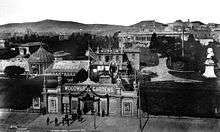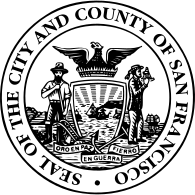Woodward's Gardens
Woodward's Gardens was a combination amusement park, museum, art gallery, zoo, and aquarium operating from 1866 to 1891 in the Mission District of San Francisco, California. The Gardens covered two city blocks, bounded by Mission, Valencia, 13th, and 15th Streets in San Francisco.[1] The site currently has a brick building at 1700 Mission Street, built after the 1906 San Francisco earthquake, which features a California Historical Site plaque, and the Crafty Fox Alehouse on the ground floor (formerly a restaurant called Woodward's Garden).[2] The former Gardens site also features the current location of the San Francisco Armory, completed in 1914.
 Woodward's Gardens in San Francisco, California circa 1880s showing Gus Buisley’s balloon ascending (Society of California Pioneers #C050292) | |
| Location | San Francisco, California |
|---|---|
| Coordinates | 37.768°N 122.421°W |
| Opened | 1866 |
| Closed | 1891 |
| Status | Closed |
.jpg)
.jpg)
History
.jpg)
Woodward's Gardens was owned and operated by Robert B. Woodward (1824–1879), who became wealthy during the Gold Rush of 1849 and through his ownership the What Cheer House, a hotel and inn at 527-531 Sacramento Street at Leidesdorff Alley in San Francisco.[3] Woodward opened the Gardens on the site of his four-acre estate after moving to Napa, California with his wife and four children (Napa home pictured). Early in his career, photographer Eadweard Muybridge took many photographs of the Gardens.[4] Woodward had bought the property from U. S. Senator John C. Fremont.[5]

In 1877, Miriam Leslie described Woodward's Gardens as "open to the public, who, for twenty-five cents each soul, may spend the day in rambling among shady groves, verdant lawns, flowery bosquets, lakes, streams and waterfalls, conservatories, ferneries, using the swings, the trapezes, the merry-go-rounds at will" [6]
In November 1889 Woodward's Gardens housed the famous bear "Monarch", a bear that was later memorialized on the Flag of California. Monarch was one of the last known wild grizzly bears captured in California and more than 20,000 people attended the opening day unveiling on November 10, 1889.[7]
The venue would attract up to 10,000 people on major holidays such as May Day. The facility lost popularity after Woodward's death in 1879, and finally closed in 1891. When the Woodward family auctioned off the collection in 1894, much of it was purchased by San Francisco philanthropist Adolph Sutro. Sutro displayed some of the Woodward's Gardens collection at his Cliff House beginning in 1896, and at his Sutro Baths in the early part of the 20th century.[5]
A book by Marilyn Blaisdell, San Francisciana Photographs of Woodward's Gardens, includes 100 photos of the site, was published in October 2012.[5]
References
- Beebe Turrill, Charles (1876). "Woodward's Gardens - 1876". www.sfmuseum.net. San Francisco, CA: California Notes, E. Bosqui & Co. Retrieved 2019-06-17.
- Bevk, Alex (2012-04-23). "Hidden Histories: Woodward's Gardens". Curbed SF. Retrieved 2019-06-17.
- "Early Resorts, Where the "Old Town" Frolicked". San Francisco History. San Francisco Chronicle. 9 November 1913. Retrieved 2019-06-17.
- Woodward's Gardens entry at San Francisco Memories
- Peter Hartlaub, "Woodward's Gardens Comes to Life in New Book", San Francisco Chronicle (October 30, 2012)
- Leslie, Mrs Frank (1877). California: a pleasure trip from Gotham to the Golden Gate, April, May, June, 1877. New York: G.W.Carleton & Co. Retrieved 29 October 2019.
- "The Monarch Bear Institute". Retrieved Nov 4, 2013.
External links
- Woodward's Gardens at NoeHill website, including photo of State of California historic plaque at site, marking the site as California Landmark 454
- Photo of Woodward's Garden (c. 1860) and History at FoundSF
- Alex Bevk, "Woodward's Gardens: Hidden Histories", Curbed SF (April 23, 2012)
- Woodward's Gardens entry at Waymarking
- Woodward's Gardens at San Francisco Memories
- Essay "Woodward's Gardens" from California Notes (1876) by Charles Beebe Turrill at SF Museum
- Photos at the SF Main Library Historic Photo Collection
- Finding aid for Woodward Gardens collection located at the Sutro Library, San Francisco, CA.
